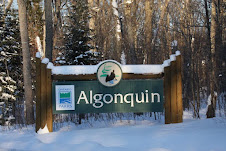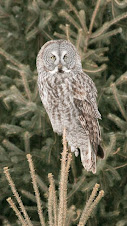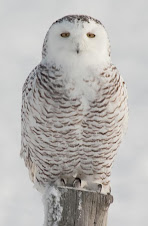The results of the Algonquin Park Christmas Bird Count on January 2 were
posted to Ontbirds on January 4, and give a good overview of the birds
present here now.
Additional information:
Spruce Grouse: no reports. Try Spruce Bog Boardwalk and Opeongo Road in
black spruce areas.
Wild Turkey: one at Lake of Two Rivers on December 31.
Black-backed Woodpecker: one was calling from the black spruce bog east of
the bridge on Opeongo Road on January 7.
Gray Jay: present at Visitor Centre feeder and Opeongo Road at gate.
Boreal Chickadee: three along Spruce Bog Boardwalk on January 3.
White-throated Sparrow: one still at Visitor Centre feeder today.
Pine Grosbeak: female still coming fairly regularly to the Visitor Centre
feeder. Nine on Highway 60 between West Gate and west boundary on December
31.
Pine Siskin: two at Visitor Centre feeders with goldfinches on January 7.
American Goldfinch: flock of 85 plus coming daily to Visitor Centre feeder.
Evening Grosbeak: Group of three flying over old railway at East Boundary on
January 2. Birders looking for this species should check feeders in Whitney
(on Highway 60 east of Algonquin Park) and Oxtongue Lake (on Highway 60 west
of Algonquin Park).
Mammals:
Marten (at least two) and a Fisher continue to come to the Visitor Centre
feeders, but with no predictable timing. Moose are being observed regularly
along Highway 60, especially near dawn and dusk.
We would appreciate receiving your bird observations for our Visitor
Centre records.
Ron Tozer
Algonquin Park Naturalist (retired)
Dwight, ON
Directions:
Algonquin Park is three hours north of Toronto, via Highways 400, 11 and 60.
Follow the signs, which start in Toronto on Highway 400. From Ottawa, take
Highway 17 to Renfrew, then follow Highway 60 to the park. Kilometre markers
along Highway 60 in the Park go from the West Gate (km 0) to near the East
Gate (km 56). Get your park permit and the park tabloid (with a map of
birding locations mentioned here) at the gates.
The Visitor Centre at km 43 has recent bird sightings, feeders, and
information. The centre is open to the public on weekends only from 10 am to
4 pm until January 31. Birder access to the building through the service
entrance to observe the feeders is usually possible on weekdays. Hot and
cold drinks and snacks are available in the restaurant this winter on
weekends, but not full meal service.
Algonquin Park birding updates and information are available at:
www.algonquinpark.on.ca












